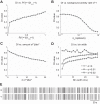Inferring neuronal network functional connectivity with directed information
- PMID: 28468991
- PMCID: PMC5547257
- DOI: 10.1152/jn.00086.2017
Inferring neuronal network functional connectivity with directed information
Abstract
A major challenge in neuroscience is to develop effective tools that infer the circuit connectivity from large-scale recordings of neuronal activity patterns. In this study, context tree maximizing (CTM) was used to estimate directed information (DI), which measures causal influences among neural spike trains in order to infer putative synaptic connections. In contrast to existing methods, the method presented here is data driven and can readily identify both linear and nonlinear relations between neurons. This CTM-DI method reliably identified circuit structures underlying simulations of realistic conductance-based networks. It also inferred circuit properties from voltage-sensitive dye recordings of the buccal ganglion of Aplysia. This method can be applied to other large-scale recordings as well. It offers a systematic tool to map network connectivity and to track changes in network structure such as synaptic strengths as well as the degrees of connectivity of individual neurons, which in turn could provide insights into how modifications produced by learning are distributed in a neural network.NEW & NOTEWORTHY This study brings together the techniques of voltage-sensitive dye recording and information theory to infer the functional connectome of the feeding central pattern generating network of Aplysia. In contrast to current statistical approaches, the inference method developed in this study is data driven and validated by conductance-based model circuits, can distinguish excitatory and inhibitory connections, is robust against synaptic plasticity, and is capable of detecting network structures that mediate motor patterns.
Keywords: Aplysia californica; buccal ganglion; context tree maximizing; directed information; functional connectivity.
Copyright © 2017 the American Physiological Society.
Figures









References
-
- Av-Ron E, Byrne MJ, Byrne JH, Baxter DA. SNNAP: a tool for teaching neuroscience. Brains Minds Media 3: bmm1408, 2008.
MeSH terms
LinkOut - more resources
Full Text Sources
Other Literature Sources

